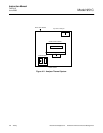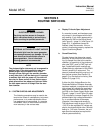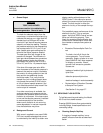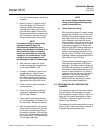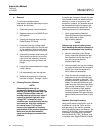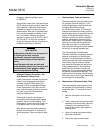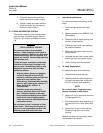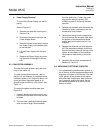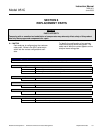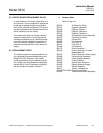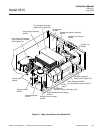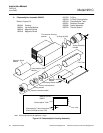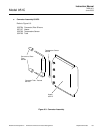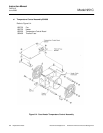
Instruction Manual
748214-V
June 2009
Rosemount Analytical Inc. A Division of Emerson Process Management Routine Servicing 5-7
Model 951C
c. Power Supply Removal
To remove the Power Supply, do the fol-
lowing:
Refer to Figure 6-1.
1. Remove the lamp and housing as in
Section 5-4b.
2. Disconnect the power lead from the
Power Supply Board.
3. Remove the two screws which secure
the Power Supply to the bottom plate
of the analyzer.
4. Lift the Power Supply from the ana-
lyzer.
5. Replace the Power Supply by revers-
ing the order of the steps in this sec-
tion.
5-5 CONVERTER ASSEMBLY
To check the heater blanket, verify the conti-
nuity of the heater coil.
To check the temperature sensor, refer to
Section 3-4 and measure its resistance when
instrument power is off (should be about 440
ohms) and when instrument power is on
(should range from 800 to 1,000 ohms). See
Table 3-1.
To remove the glass converter tube (see
Figure 6-4):
1. Carefully disconnect the blue silicon con-
nectors from the ends of the inlet and out-
let tubes.
2. The inlet tube is partially filled with glass
wool and has a larger inside diameter
than the outlet tube. Further, the outlet
tube and the sample capillary (P/N
615989) connect to the same stainless
steel tee.
3. Release the assembly and disconnect the
heater and sensor connectors from the
temperature control board.
4. Remove the lacing from the heater blan-
ket, and remove the converter tube. Note
the position of the temperature sensor
and its leads as the aluminum foil is un-
wrapped.
5. Replace the defective part and reassem-
ble. The temperature sensor should con-
tact the converter tube with the top of the
sensor at the midpoint of the converter.
Route sensor leads axially to the outer
end.
6. Condition the converter as described in
Sections 3-4 and 3-5.
5-6 SERVICING ELECTRONIC CIRCUITRY
For troubleshooting the electronic system, re-
fer to Section 4.0 and the appropriate pictorial
diagrams at the back of the manual. The elec-
tronic system utilizes printed circuit boards
with solid-state components. After a malfunc-
tion is traced to a particular board, the rec-
ommended procedure is to return it to the
factory for repair.



